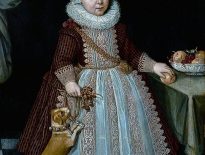On this day in Tudor history, Thursday 12th January 1559, Queen Elizabeth I travelled by barge from Whitehall to the Tower of London to prepare for her coronation, which was due to take place on the 15th January.
Of course, her journey wasn't a low key one in a normal river barge, it was a lavish one with decorated barges, music and the usual artillery fire. Find out all about this river procession in today's talk.
Here are the other videos mentioned:
Also on this day in Tudor history, 12th January 1510, Henry VIII jousted for the first time as king. He and his good friend, William Compton, jousted in disguise, and there was panic when one of them was injured. Find out more in last year's video:
Also on this day in history:
- 1519 – Death of Maximilian I, Holy Roman Emperor, in Wels, Upper Austria. He was buried in the Castle Chapel at Wiener Neustadt, but visitors to the Hofkirche Court Church in Innsbruck can see a cenotaph tomb for Maximilian there because the church was built in memory of Maximilian by his grandson, Ferdinand I.
- 1539 - Francis I of France and Charles V, Holy Roman Emperor, signed the Peace of Toledo, agreeing to make no other alliances without the consent of the other.
- 1547 - Thomas Howard, 3rd Duke of Norfolk, who was imprisoned in the Tower of London, tried to save himself from execution by signing a confession.
- 1560 – Death of John White, Bishop of Winchester, in South Warnborough. He was buried in Winchester Cathedral. White was a Catholic, was imprisoned in the Tower of London and deprived of his bishopric after the accession of Elizabeth I.
- 1573 – Death of William Howard, 1st Baron Howard of Effingham, soldier and naval commander, at Hampton Court. He was buried at Reigate Church. Howard was the fourth son of Thomas Howard, 2nd Duke of Norfolk, and his second wife, Agnes Tilney.
- 1577 – Death of Thomas Fisher (also known as Hawkins), landowner and MP. The first record of Fisher shows him serving John Dudley, who was then Viscount Lisle, but by 1544 he was working for Edward Seymour, Earl of Hertford. In Mary I's reign, he served as a Justice of the Peace and member of Parliament. He was buried in St Mary's Church, Warwick, in a tomb with his first wife, Winifred.
- 1587 – Death of Matthew Godwin, Organist and Choirmaster at the Cathedral Churches of Canterbury, then Exeter.
Transcript:
I travelled by barge from Whitehall to the Tower of London to prepare for her coronation, which was scheduled for the 15th January, an auspicious date chosen by her astrologer and advisor, John Dee.
The Venetian ambassador gave an account of Elizabeth’s journey along the River Thames:
“Her Majesty, being pleased to follow the example of her ancestors about the Coronation, determined to have it performed on the 15th January of this year 1559; so she left her palace of Whitehall on Thursday the 12th to go to the Tower by water. The necessary ships, galleys, brigantines, &c, were prepared as sumptuously as possible to accompany her Majesty and her Court thither by the Thames, which reminded me of Ascension Day at Venice, when the Signory go to espouse the sea.
At 2 p.m., the flood-tide then serving to pass under London Bridge, her Majesty, accompanied by many knights, barons, ladies, and by the whole Court, passing through the private corridor, embarked in her barge, which was covered with its usual tapestries, both externally and internally, and was towed by a long galley rowed by 40 men in their shirts, with a band of music, as usual when the Queen goes by water. Her Majesty having passed the bridge, in sight of the Tower, some pieces of artillery were fired; she landed at the private stairs, and, entering by a little bridge, was seen but by very few persons.”
Another contemporary account can be found in Raphael Holinshed’s chronicles:
“On thursday the twelf of January, the queen removeth from her palace of Westminster by water unto the tower of London, the lord mayor and aldermen in their barge, and all the citizens with their barges decked and trimmed with targets and banners of their mysteries accordingly attending on her grace.
The bachelors’ barge of the lord mayor’s company, to wit, the mercers had their barge with a foist trimmed with three tops, and artillery aboard, gallantly appointed to wait upon them, shooting off lustily as they went, with great and pleasant melody of instruments, which played in most sweet and heavenly manner. Her grace shut the bridge about two of the clock in the afternoon, at the still of the ebb, the lord mayor and the rest following after her barge, attending the same, till her majesty took land at the privy stairs at the tower wharf: and then the said lord mayor with the other barges returned, passing through the bridge again with the flood, and landed at the wharf of the three cranes in the Vintrie.”
By the way, the Vintrie was a large wine store located in the City of London.
As was traditional during coronation celebrations, on the following day, 13th January, at the Tower of London, Elizabeth I created 11 Knights of the Bath: John Darcy, 2nd Lord Darcy of the North; John Sheffield, 2nd Lord Sheffield of Butterwick; John Darcy, 2nd Lord Darcy of Chiche; Robert Rich; Roger North; John de la Zouche of Zouche; Nicholas Poyntz; John Berkeley; Edward Unton; Henry Weston, and George Speke.
Her coronation procession through the streets of London from the Tower to Westminster took place on 14th January 1559 and then she was crowned on 15th.



We believe it is ridiculous today to leave our main decisions to astrological charts and such like, however back then it was taken very seriously and Dr John Dee was one who mixed Mathematics, Astrology and Astronomy and Medicine and was relied upon by Elizabeth I. Some people read manure, the entrails and other nasty stuff but Dee would do a chart and Elizabeth went by this
Elizabeth went by this man’s readings for much of her life. Dee was considered a scholar and wrote several large tomes on natural sciences and other topics. Elizabeth considered him a friend.